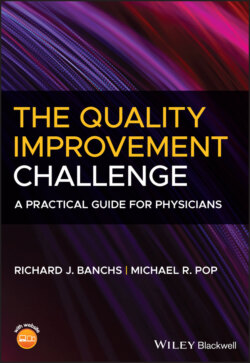Читать книгу The Quality Improvement Challenge - Richard J. Banchs - Страница 20
CHAPTER 2 We Need to Improve the Way We Improve WHAT’S THE GOAL OF A QI PROJECT? First, Define Quality
ОглавлениеThe goal of healthcare is to provide quality care. The traditional quality paradigm was centered on the provider’s point of view and the notion that quality care was effective care. But expectations have changed, and the paradigm has evolved to one centered on the patient’s perspective, which includes not only the treatment but the healthcare experience. Quality is no longer just “effective” care. Quality is now defined as much by the therapeutic intervention as by how we meet patients’ expectations. In 2001, the Institute of Medicine defined quality along six dimensions: effective, efficient, timely, safe, patient‐centered, and equitable (IOM 2001). In this new paradigm, assessing quality requires us to evaluate “what” was provided i.e. effective and safe care, as well as “how” it was provided, i.e. efficient, timely, culturally sensitive, and equitable care (see Figure 2‐1).
FIGURE 2‐1 The new quality paradigm.
Patients remain at the center of our delivery system because they are the reason healthcare organizations exist. Clinicians provide care to patients and expert services to other providers. Leaders and ancillary staff support the providers’ clinical practice within a complex, multidimensional system. Together, their efforts yield the patient’s outcomes and experiences. Our aim is to provide care that is effective in addressing the disease process, and is delivered in an efficient, timely, safe, patient‐centered, and equitable manner. This paradigm shift has redefined not only quality but the role of the healthcare provider. It is no longer sufficient to provide treatment for a patient’s clinical condition; we must also improve the quality of the healthcare delivery system to address patients’ expectations of the holistic care experience.
